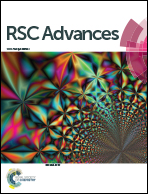One step hydrothermal synthesis of a rGO–TiO2 nanocomposite and its application on a Schottky diode: improvement in device performance and transport properties†
Abstract
The presence of a Schottky barrier (SB) at a metal–semiconductor (MS) interface is of paramount importance to numerous application fields. In this report, we demonstrate the performance comparison of Schottky diodes fabricated with TiO2 and rGO–TiO2 nanocomposites, in contact with aluminium. From forward I–V characteristics, important diode parameters i.e. rectification ratio, ideality factor, series resistance and barrier height were obtained. A photoresponse comparison of the diodes has also been performed. It was found that the rGO–TiO2 based junction showed improved performance. The rectification ratio increased by ∼94% and the barrier height was lowered by ∼10%, under dark conditions. For better realization of the junction, here we provide insight into the carrier transport properties with the help of space charge limited current (SCLC) theory. After introducing graphene, the carrier mobility and carrier concentration increased by 64% and 21% respectively, while the diffusion length is found to be improved by 13.4%. These results illustrate that rGO incorporation has led to a much improved carrier transport and electron hole separation. Due to greater light absorption, the improvement in diode parameters and transport properties were even better when the device was subjected to irradiation.


 Please wait while we load your content...
Please wait while we load your content...